Physical Examination in Multiple Sclerosis (MS)
Physical Examination
in Multiple Sclerosis (MS)
Multiple sclerosis is a disease with a progression that is individual and difficult to predict. In order to achieve the best possible treatment result for the patient, certain MS-specific aspects have to be taken into account when producing an orthosis. An important factor in the physical examination is the consideration of muscular fatigue. In this online tutorial, you will first note the patient data including the muscle strength without fatigue. The 6-minute walk test is then used to induce the state of muscular fatigue and the muscle strength is assessed again for comparison.
In the Orthotic Treatment Sheet for MS Patients, you can record the collected data. In our MS Guide, you will also find a concept for the examination and orthotic treatment of patients with multiple sclerosis.
-
Body Weight and Height
-
Step 1/2
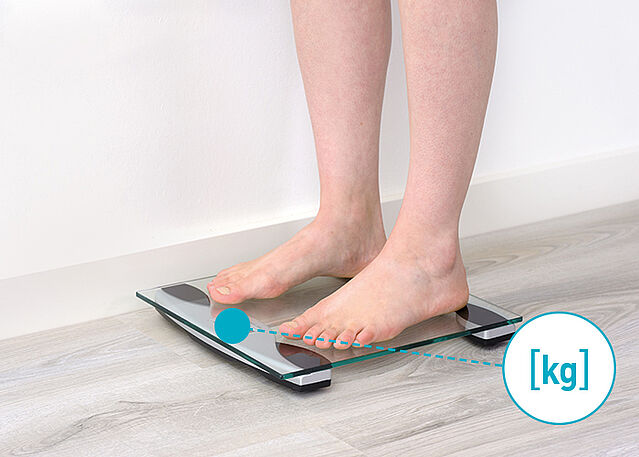
Determine the body weight. Foreseeable changes due to growth should be taken into account.
Step 2/2
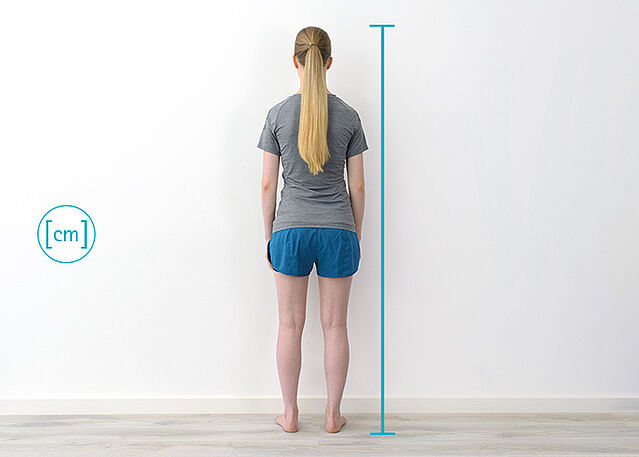
Determine the body height. Foreseeable changes due to growth should be taken into account.


-
Range of Mation in the Upper Ankle Joint
-
Step 1/10
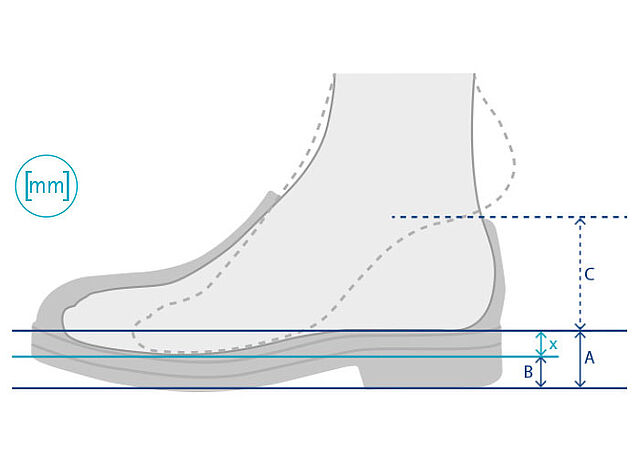
Determine pitch x of the shoe (difference between heel height A and sole thickness B in the ball area). Measure A and B and apply the formula x = A - B. Transfer the determined pitch to the h-Cast.
C is a possible height compensation.Step 2/10
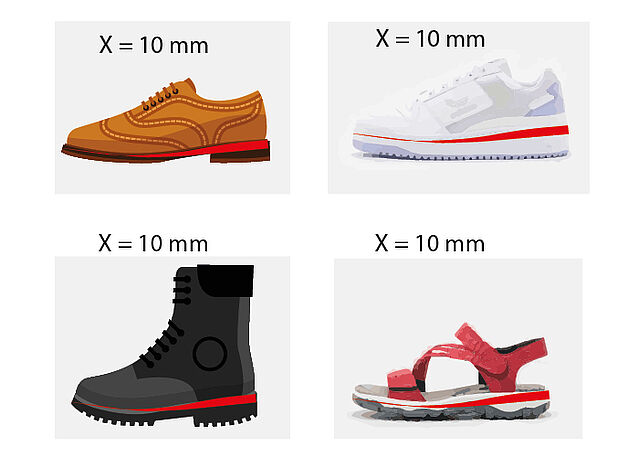
Step 3/10
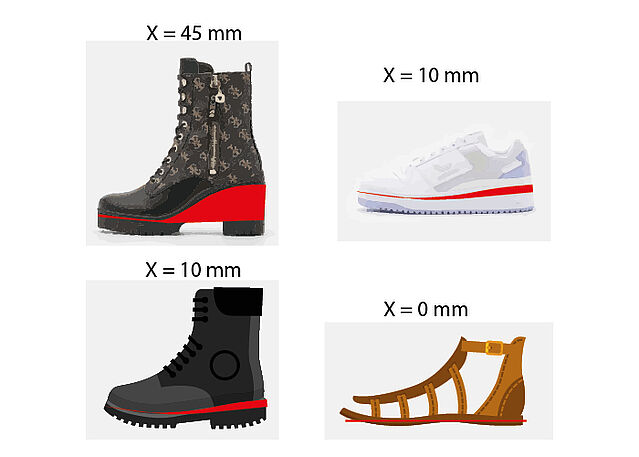
If the shoe models have a different pitch x, there are two options:
1. The orthosis is equipped with a system joint that can be adjusted to different pitches. This is the case with the NEURO HiSWING system ankle joint.
2. The patient chooses a set pitch.
For option 1: determine the maximum and minimum value of pitch x of the different shoe models. Calculate the mean value. This value is needed for making the negative cast. For all other work steps, use the maximum value of pitch x.Step 4/10
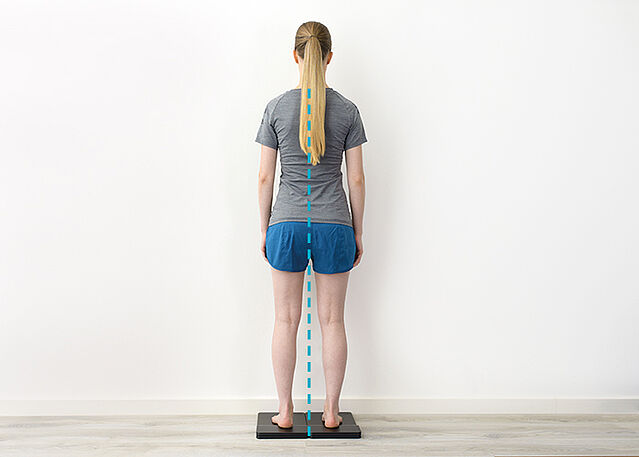
The patient is standing on the h-Cast. Check if the patient stands in a plumb line, e.g. by using a laser plumb bob. The plumb bob should fall from the 7th cervical vertebrae (C7) through the cleft between the buttocks and the middle of the supportive area of both feet. If this is not the case – e.g. due to a unilateral contracture – the patient requires a height compensation. Determine the height compensation (see C at step 1) and transfer it to the h-Cast. Check the result.
Note: if the patient is unable to stand (even with assistance), determine the height compensation e.g. while lying.Step 5/10
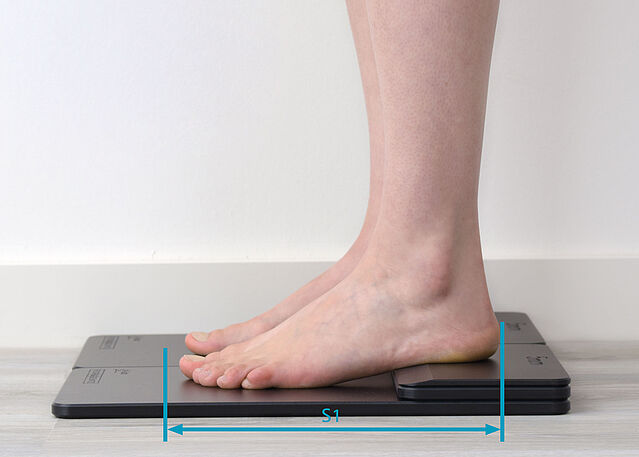
Determine the shoe size (S1) by measuring the foot length and applying the formula (foot length + 1.5cm) x 1.5. If the feet differ in length, write down the larger shoe size.
Step 6/10
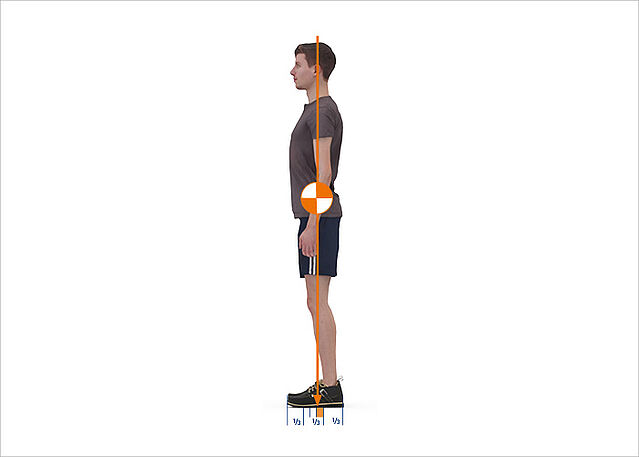
Check the individual normal posture in the sagittal plane with the help of a laser plumb bob. The plumb bob should fall as follows:
- from the body’s centre of gravity,
- across the greater trochanter,
- centrally through the ap measurement at knee height,
- to the rear third of the front half of the supportive area.
With extension deficits, the knee joint does not serve as a reliable point of orientation. If this is the case, get as close to the above-mentioned fixed points as possible.
Write down if the plumb line falls through or before the knee’s pivot point.
Note: take the length difference of the feet into account, if present.
Note: if the patient is unable to stand (even with assistance), mark the plumb bob reference area (orange) on a stencil and write down the values.Step 7/10
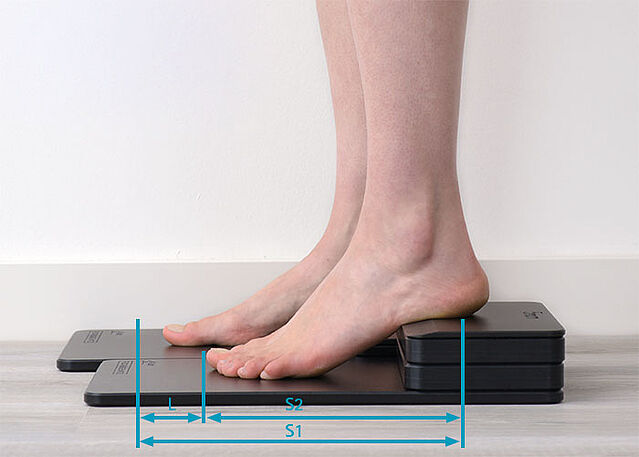
Determine the length difference L. Measure S1 and S2 and apply the formula L = S1 - S2. Write down the length difference L in order to be able to compensate the difference during the following steps.
Note: if the patient is unable to stand (even with assistance), use a stencil for markings and write down the values.
Important! For a symmetrical stride length, there should be equal leverage ratios on both sides. To achieve that, the rolling-off line’s position and the heel lever must be adjusted in case of a functional shortening (e.g. due to a height compensation).Step 8/10
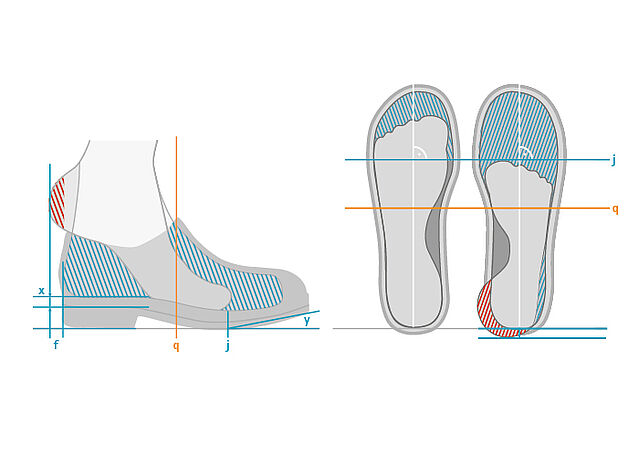
When producing a height compensation, it is essential to create a leverage ratio that is similar to the contralateral side. To do so, the following steps are necessary:
- compensate the volume under the heel and in the forefoot area (blue hatching)
- set the heel back (pink hatching)
- define the mechanical rolling-off line (j)
- consider the heel-to-toe drop (x )
- consider the toe spring (y)
Note: mark the plumb and rolling-off line of the healthy/unaffected foot on the shoe’s insole (or a stencil) and use the values as a guidance for all further steps.
Step 9/10
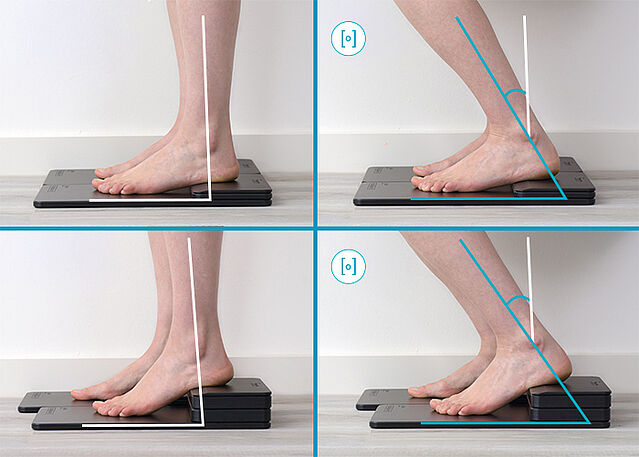
The range of motion in the upper ankle joint in dorsiflexion is measured based on the individual normal posture. Position the patient on the h-Cast, taking into account the leg length/height compensation and the shoe pitch. Measure the range of motion of the upper ankle joint in dorsiflexion based on the individual normal posture.
Note: if the patient is unable to stand (even with assistance), place them on a chair and push their feet back on the h-Cast until the heel lifts from the plate.Step 10/10
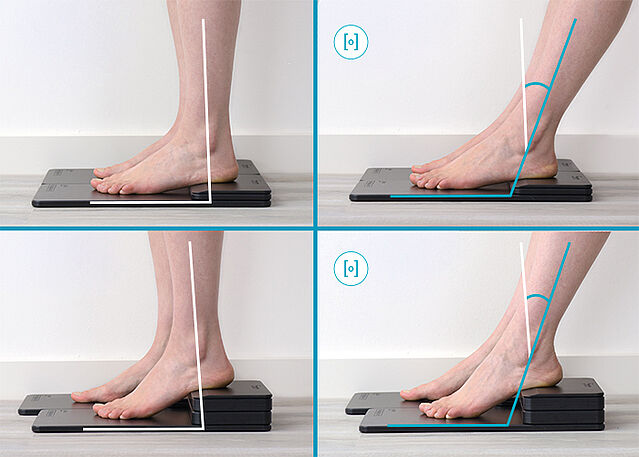
The range of motion in the upper ankle joint in plantar flexion is measured based on the individual normal posture. Position the patient on the h-Cast, taking into account the leg length/height compensation and the shoe pitch. Measure the range of motion of the upper ankle joint in plantar flexion based on the individual normal posture.
Note: if the patient is unable to stand (even with assistance), place them on a chair and push their feet forward on the h-Cast until the forefoot lifts from the plate.









-
Joint Angles
-
Step 1/6
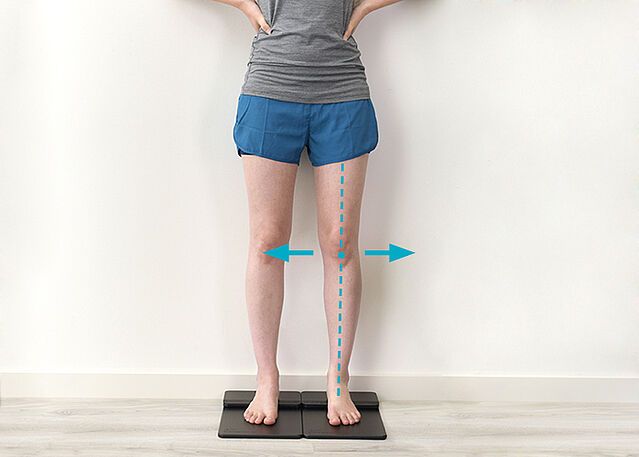
The patient is standing on the h-Cast with their patella facing forward. Check whether the leg axis deviates from the neutral position (deformities).
Step 2/6
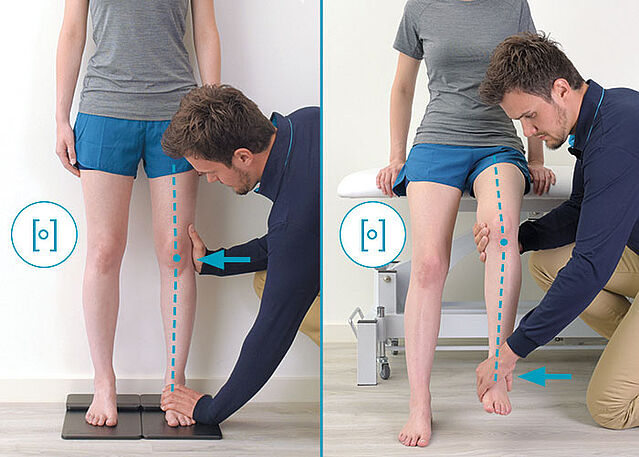
If there is a deviation in varus, correct it as much as possible and determine the value estimated with orthosis of the corrected varus deformity. If the deformity cannot be corrected, we recommend that you still use the box on the General Orthotic Treatment Sheet to document the estimated value. Then, determine the maximum varus deformity without load on the leg. If the values match, there is a deformity, but no instability.
Note: if the patient is unable to stand (even with assistance), determine the approximate values in a sitting position.Step 3/6
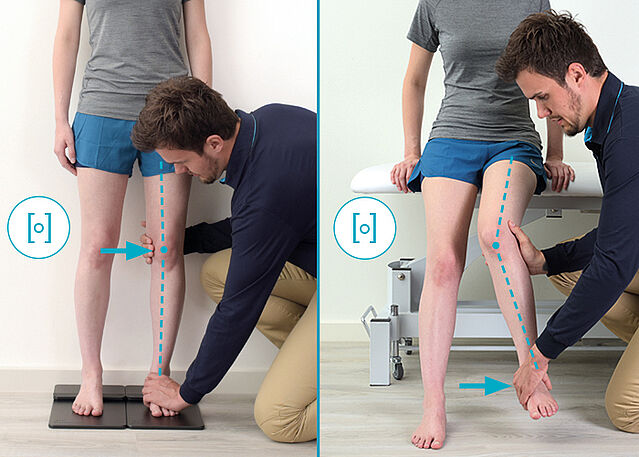
If there is a deviation in valgus, correct it as much as possible and determine the value estimated with orthosis of the corrected valgus deformity. If the deformity cannot be corrected, we recommend that you still use the box on the General Orthotic Treatment Sheet to document the estimated value. Then, determine the maximum valgus deformity without load on the leg. If the values match, there is a deformity, but no instability.
Note: if the patient is unable to stand (even with assistance), determine the approximate values in a sitting position.Step 4/6
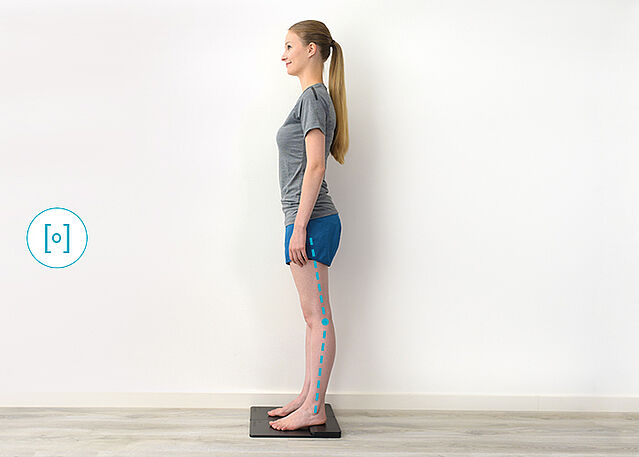
Measure the maximum knee hyperextension. Correct it, if possible, to achieve a physiological knee angle. Due to patient-specific conditions, this may not be attainable in some cases. In any case, determine the hyperextension estimated with orthosis (e.g. 4°). All values, which exceed 0° flexion (e.g. 4° flexion), undo any hyperextension and are marked as 0°.
Note: if the patient is unable to stand (even with assistance), determine the approximate values in a sitting position. Keep in mind that the angles of the upper ankle joint and hip affect the knee angle.Step 5/6
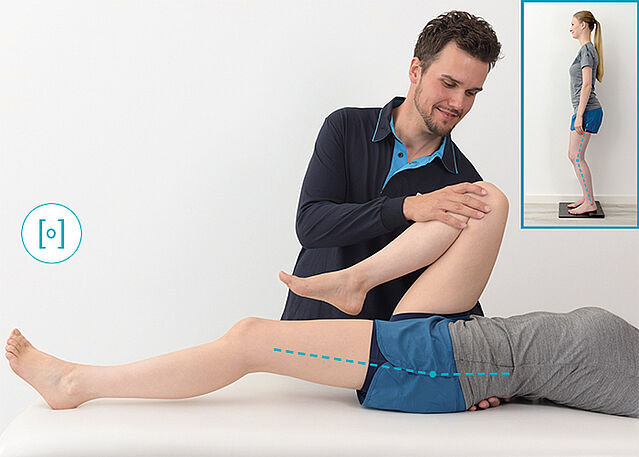
Apply the Thomas test to determine the extension limitation of the hip. The patient is lying on their back. Place one hand under the lumbar vertebrae to check the reduction in the curve of the lumbar spine.
Bring the leg not to be tested into hip flexion with the knee bent. The hip flexion angle is measured on the side to be tested. Note that the extension limitation of the hip estimated with orthosis can affect the individual normal posture in the sagittal plane.Step 6/6
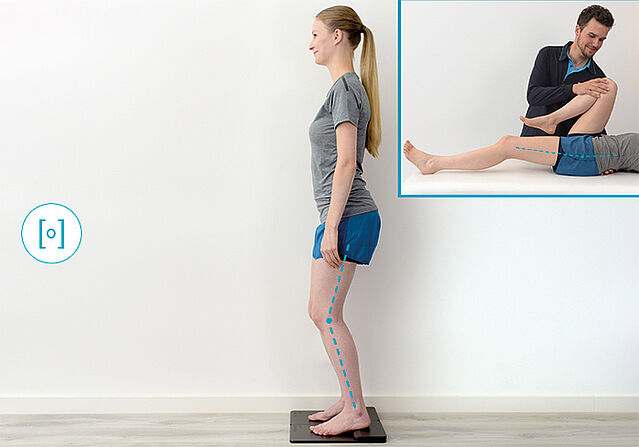
The patient is standing on the h-Cast. Adjust it so that all influencing factors, such as the extension limitation of the hip, are taken into account. Measure the knee angle. It deviates from the physiological angle if there is an extension limitation of the knee and/or hip. Pain can also lead to a deviation.
Note: if the patient is unable to stand (even with assistance), determine the approximate values in a sitting position. Keep in mind that the angles of the upper ankle joint and hip affect the range of motion at knee height





-
Muscle Strength - Foot
-
Step 1/10
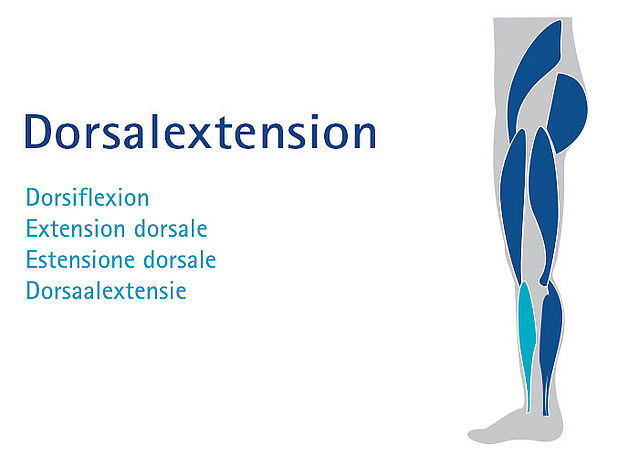
Step 2/10
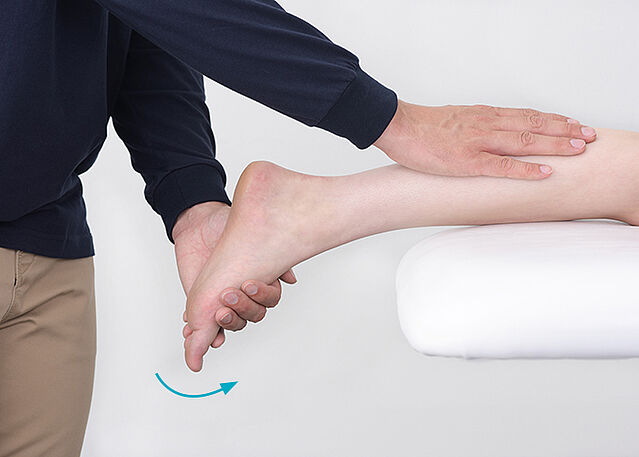
Dorsiflexion – Muscle Strength 5 and 4
The patient is lying on their stomach. The foot of the leg to be tested is hanging over the edge of the examination table. Hold the lower leg in place with one hand without restricting the muscle function. Press against the back of the foot with the other hand. Have the patient bring the foot into dorsiflexion. At complete range of motion against gravity with full resistance, the muscle strength is 5. At range of motion against gravity with some resistance, the muscle strength is 4.Step 3/10
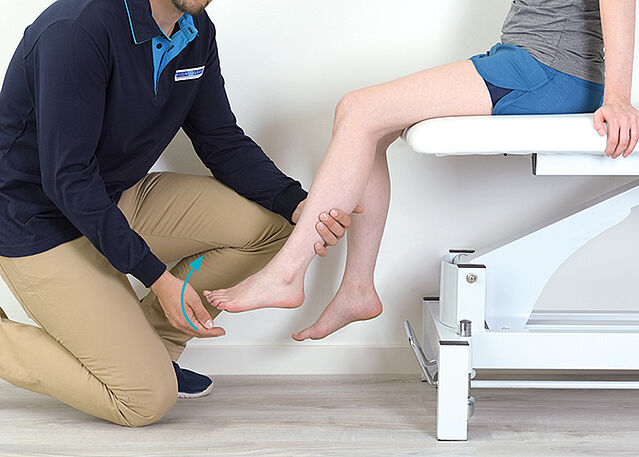
Dorsiflexion – Muscle Strength 3
The patient is seated. The lower legs are hanging over the edge of the examination table. Hold the lower leg in place with one hand without restricting the muscle function. Have the patient bring the foot into dorsiflexion. At range of motion against gravity, the muscle strength is 3.Step 4/10
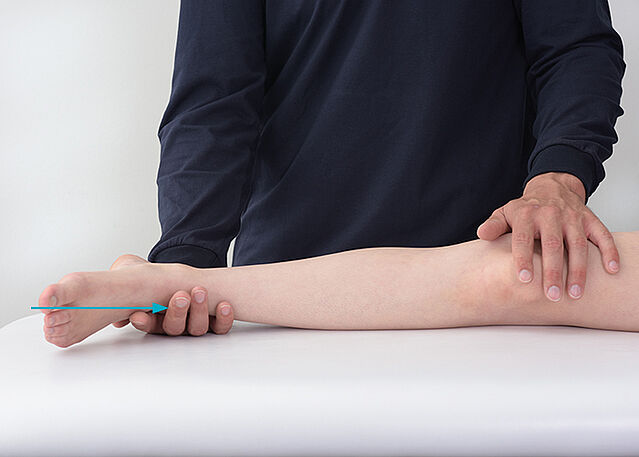
Dorsiflexion – Muscle Strength 2
The patient is lying on the side of the leg to be tested. Place one hand under the foot so that it is no longer resting on the examination table. Have the patient bring the foot into dorsiflexion. At range of motion with gravity eliminated, the muscle strength is 2.Step 5/10
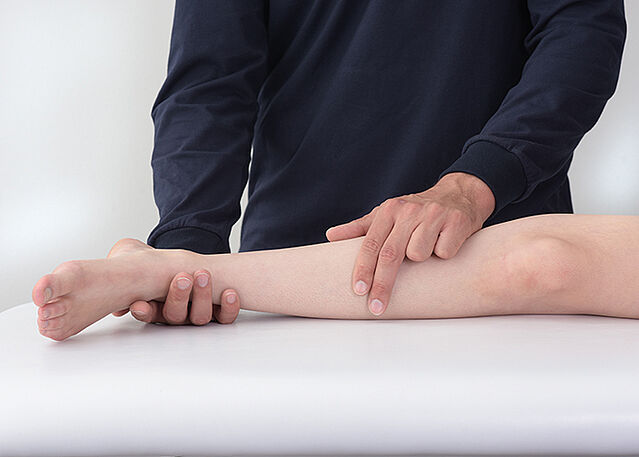
Dorsiflexion – Muscle Strength 1 and 0
The patient is lying on the side of the leg to be tested. Place one hand under the foot so that it is no longer resting on the examination table. Have the patient bring the foot into dorsiflexion. Palpate if there is any muscle activity. At slight contraction with no joint motion, the muscle strength is 1. At no evidence of contraction, there is a total paralysis and the muscle strength is 0.Step 6/10
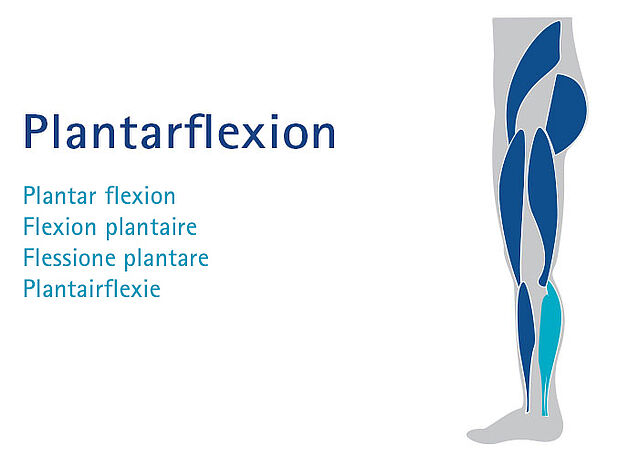
Step 7/10
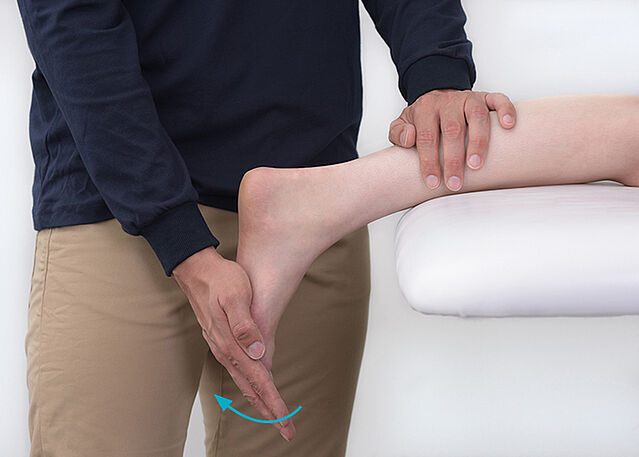
Plantar Flexion – Muscle Strength 5 and 4
The patient is lying on their stomach. The foot of the leg to be tested is hanging over the edge of the examination table. Hold the lower leg in place with one hand without restricting the muscle function. Press against the forefoot from below with the other hand. Have the patient bring the foot into plantar flexion. At complete range of motion against gravity with full resistance, the muscle strength is 5. At range of motion against gravity with some resistance, the muscle strength is 4.Step 8/10
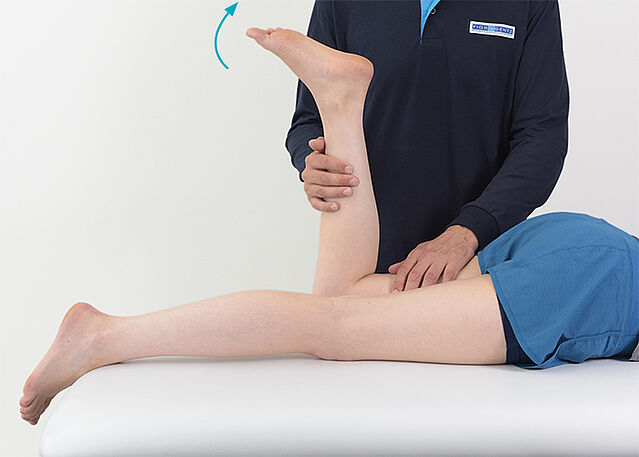
Plantar Flexion – Muscle Strength 3
The patient is lying on their stomach. The leg to be tested is flexed. Have the patient bring the foot into plantar flexion. At range of motion against gravity, the muscle strength is 3.Step 9/10
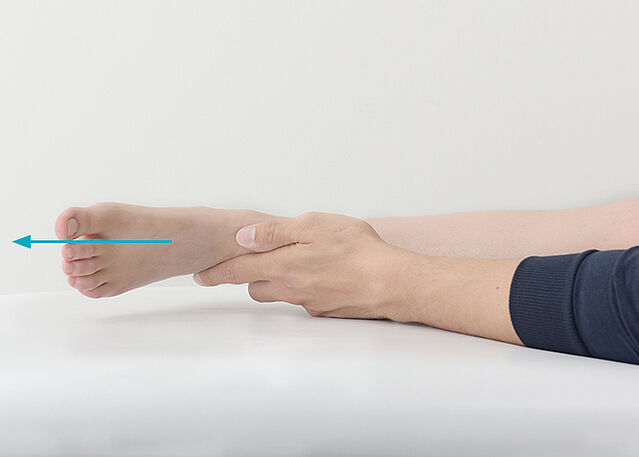
Plantar Flexion – Muscle Strength 2
The patient is lying on the side of the leg to be tested. Place one hand under the foot so that it is no longer resting on the examination table. Have the patient bring the foot into plantar flexion. At range of motion with gravity eliminated, the muscle strength is 2.Step 10/10
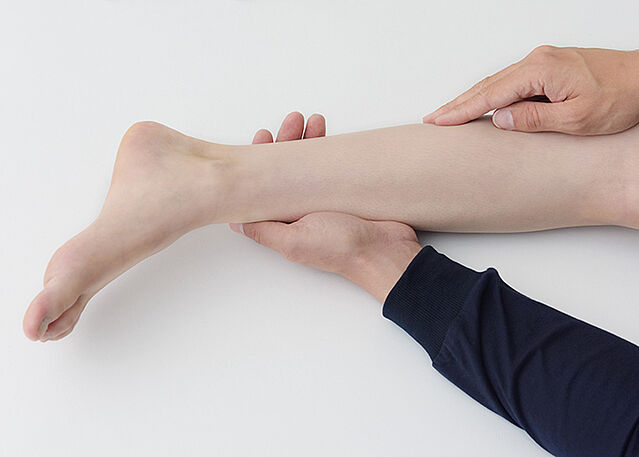
Plantar Flexion – Muscle Strength 1 and 0
The patient is lying on the side of the leg to be tested. Place one hand under the foot so that it is no longer resting on the examination table. Have the patient bring the foot into plantar flexion. Palpate if there is any muscle activity. At slight contraction with no joint motion, the muscle strength is 1. At no evidence of contraction, there is a total paralysis and the muscle strength is 0.









-
Muscle Strength - Knee
-
Step 1/10
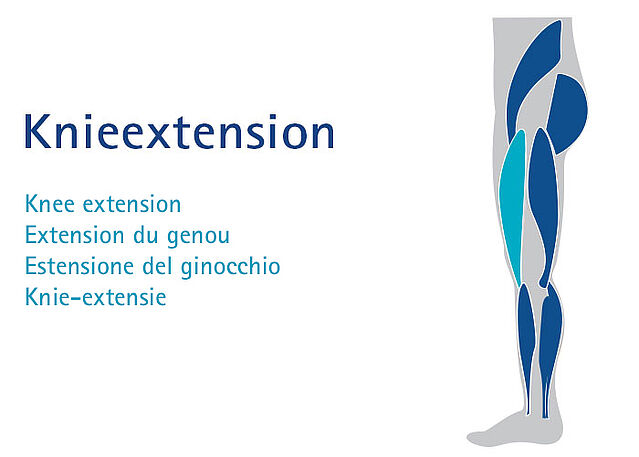
Step 2/10
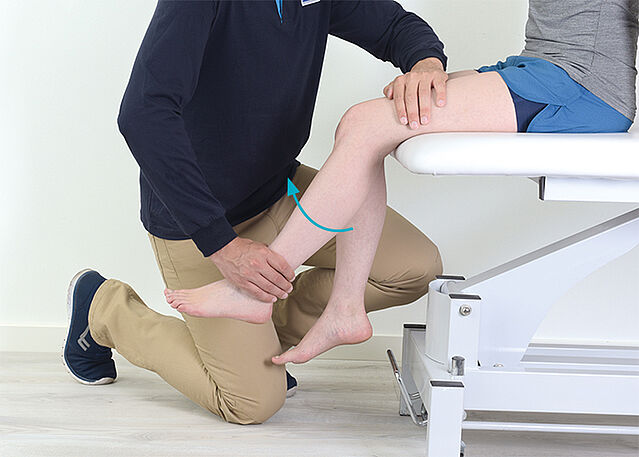
Knee Extension – Muscle Strength 5 and 4
The patient is seated. The lower legs are hanging over the edge of the examination table. Hold the thigh in place with one hand without restricting the muscle function. Press against the lower leg above the foot with the other hand. Have the patient bring the knee into extension. At complete range of motion against gravity with full resistance, the muscle strength is 5. At range of motion against gravity with some resistance, the muscle strength is 4.Step 3/10
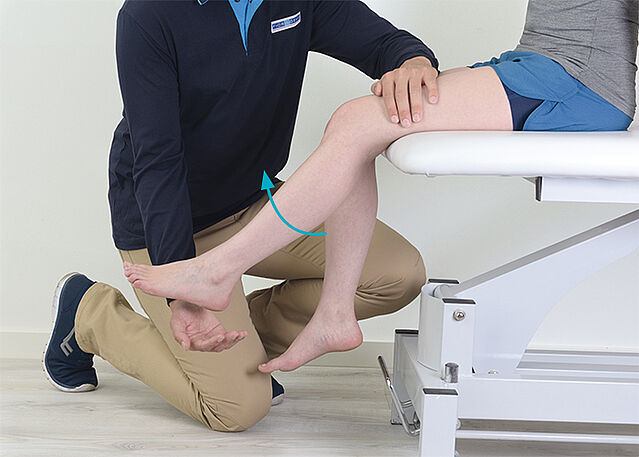
Knee Extension – Muscle Strength 3
The patient is seated. The lower legs are hanging over the edge of the examination table. Hold the thigh in place with one hand without restricting the muscle function. Have the patient bring the knee into extension. At range of motion against gravity, the muscle strength is 3.Step 4/10
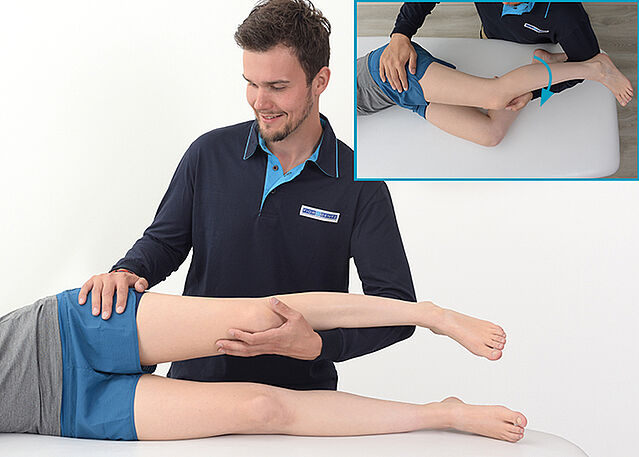
Knee Extension – Muscle Strength 2
The patient is lying on the side of the leg not to be tested. Support and lift the upper leg with one hand. Hold the pelvis in place with the other hand without restricting the muscle function. The leg to be tested is slightly flexed. Have the patient bring the knee into extension. At range of motion with gravity eliminated, the muscle strength is 2.Step 5/10
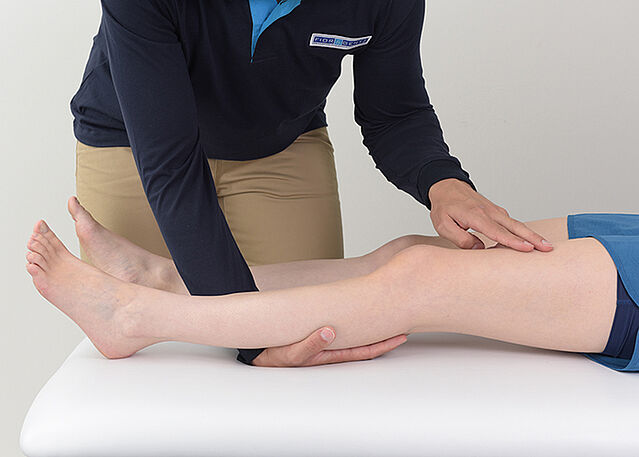
Knee Extension – Muscle Strength 1 and 0
The patient is lying on their back. The leg to be tested is slightly flexed in hip and knee. The other leg is extended. Have the patient bring the knee into extension. Palpate if there is any muscle activity. At slight contraction with no joint motion, the muscle strength is 1. At no evidence of contraction, there is a total paralysis and the muscle strength is 0.Step 6/10
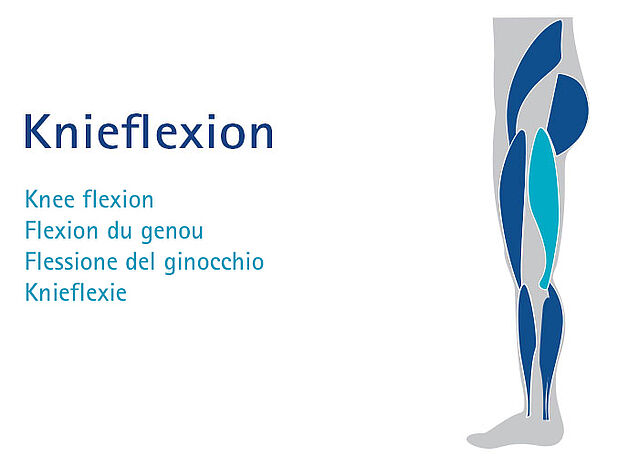
Step 7/10
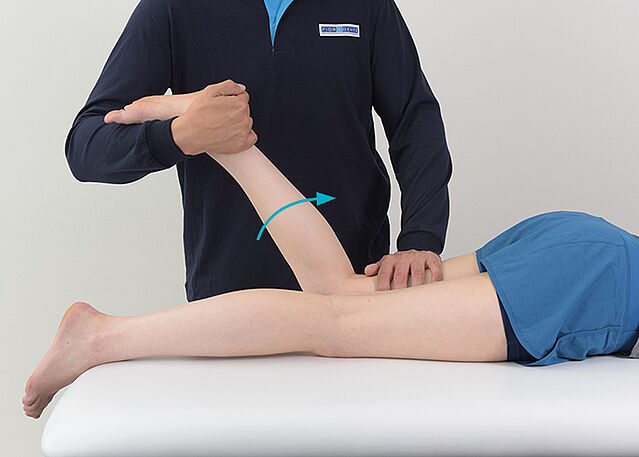
Knee Flexion – Muscle Strength 5 and 4
The patient is lying on their stomach. The foot of the leg not to be tested is hanging over the edge of the examination table and the leg to be tested is flexed. Hold the thigh in place with one hand without restricting the muscle function. Press against the lower leg close to the foot with the other hand. Have the patient bring the knee into flexion. At complete range of motion against gravity with full resistance, the muscle strength is 5. At range of motion against gravity with some resistance, the muscle strength is 4.Step 8/10
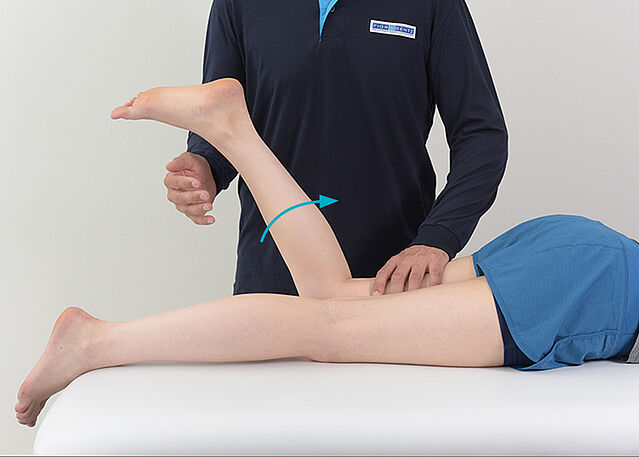
Knee Flexion – Muscle Strength 3
The patient is lying on their stomach. The foot of the leg not to be tested is hanging over the edge of the examination table and the leg to be tested is flexed. Hold the thigh in place with one hand without restricting the muscle function. Have the patient bring the knee into flexion. At range of motion against gravity, the muscle strength is 3.Step 9/10
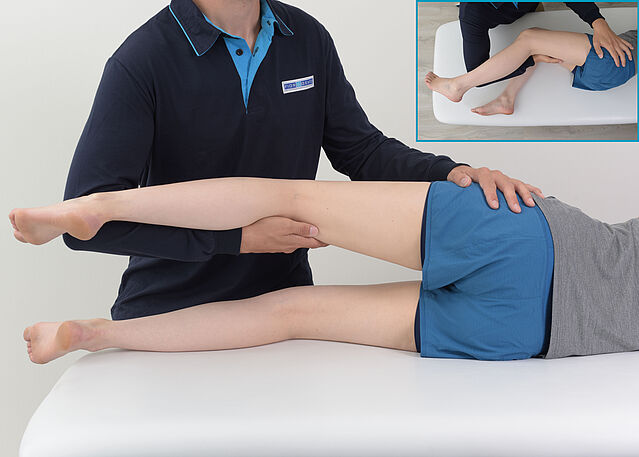
Knee Flexion – Muscle Strength 2
The patient is lying on the side of the leg not to be tested. The upper leg is slightly flexed. Support and lift the upper leg with one hand. Hold the pelvis in place with the other hand without restricting the muscle function. Have the patient bring the knee into flexion. At range of motion with gravity eliminated, the muscle strength is 2.Step 10/10
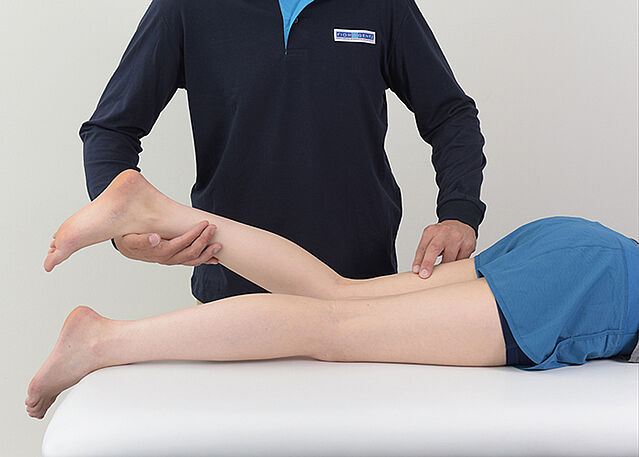
Knee Flexion – Muscle Strength 1 and 0
The patient is lying on their stomach. The foot of the leg not to be tested is hanging over the edge of the examination table and the leg to be tested is slightly flexed. Support the flexed leg with one hand. Have the patient bring the knee into flexion. With the other hand, palpate if there is any muscle activity. At slight contraction with no joint motion, the muscle strength is 1. At no evidence of contraction, there is a total paralysis and the muscle strength is 0.









-
Muscle Strength - Hip
-
Step 1/10
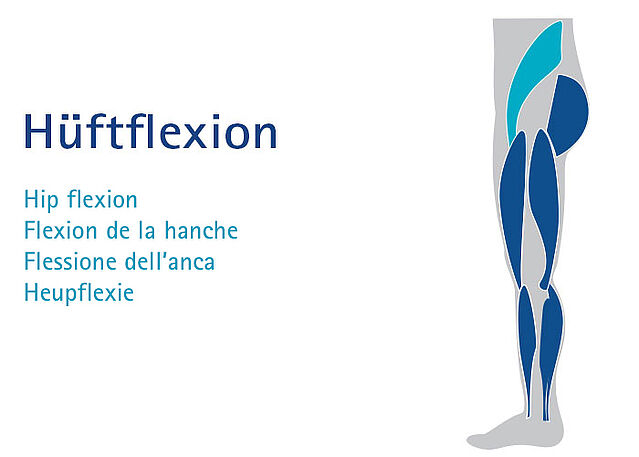
Step 2/10
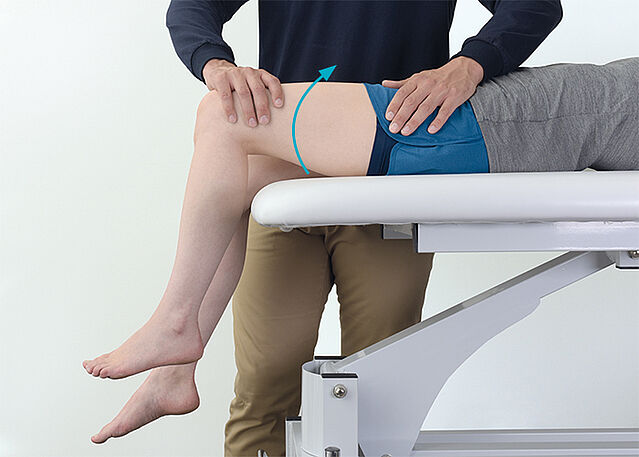
Hip Flexion – Muscle Strength 5 and 4
The patient is lying on their back. The lower legs are hanging over the edge of the examination table. Hold the pelvis in place with one hand without restricting the muscle function. Press against the thigh close to the knee with the other hand. Have the patient bring the hip into flexion. At complete range of motion against gravity with full resistance, the muscle strength is 5. At range of motion against gravity with some resistance, the muscle strength is 4.Step 3/10
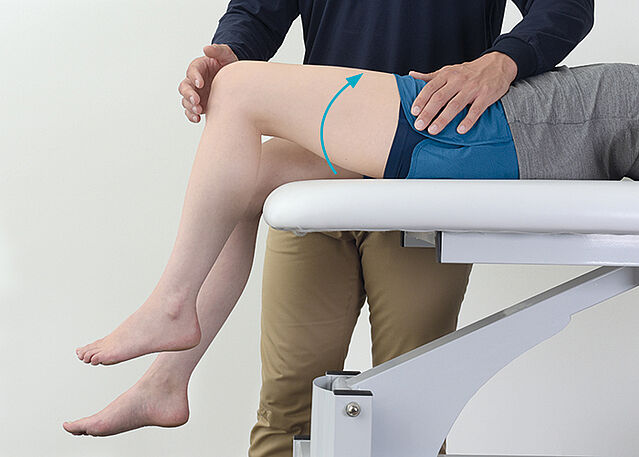
Hip Flexion – Muscle Strength 3
The patient is lying on their back. The lower legs are hanging over the edge of the examination table. Hold the pelvis in place with one hand without restricting the muscle function. Have the patient bring the hip into flexion. At range of motion against gravity, the muscle strength is 3.Step 4/10
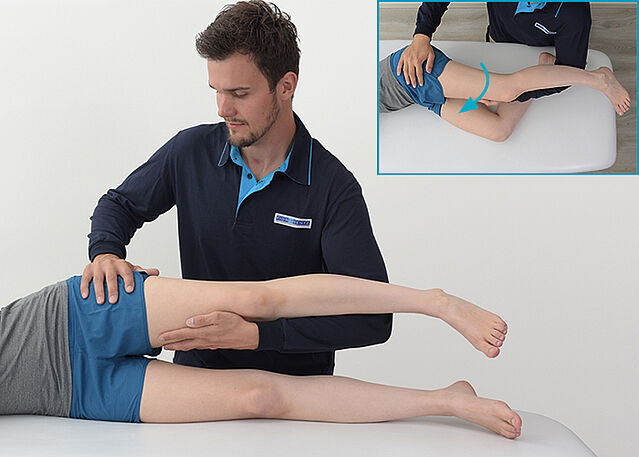
Hip Flexion – Muscle Strength 2
The patient is lying on the side of the leg not to be tested. The upper leg is slightly flexed in hip and knee. Support and lift the upper leg with one hand. Hold the pelvis in place with the other hand without restricting the muscle function. Have the patient bring the hip into flexion. At range of motion with gravity eliminated, the muscle strength is 2.Step 5/10
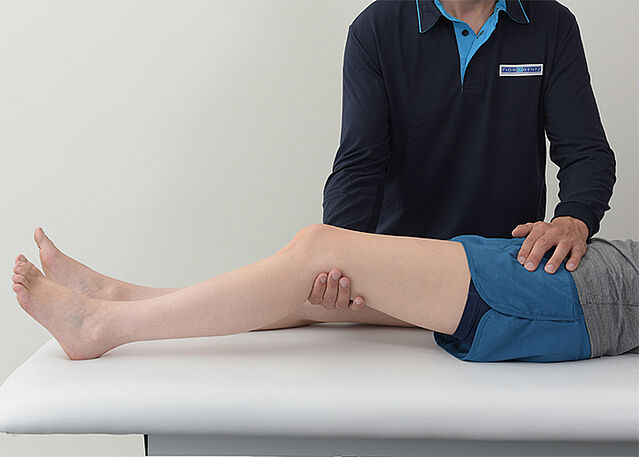
Hip Flexion – Muscle Strength 1 and 0
The patient is lying on their back. Hip and knee of the leg to be tested are slightly flexed. Support the flexed knee with one hand. Have the patient bring the hip into flexion. With the other hand, palpate if there is any muscle activity. At slight contraction with no joint motion, the muscle strength is 1. At no evidence of contraction, there is a total paralysis and the muscle strength is 0.Step 6/10
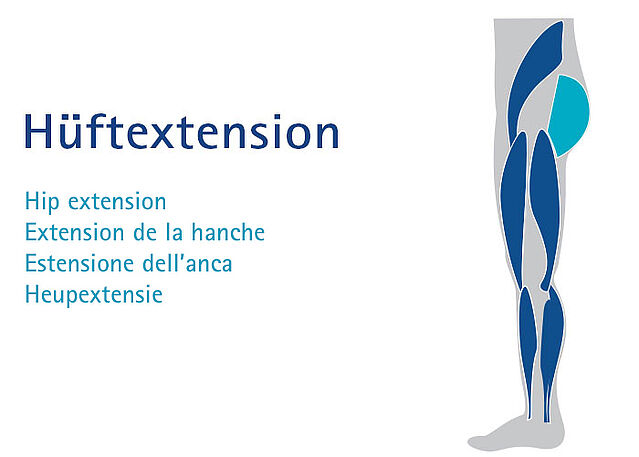
Step 7/10
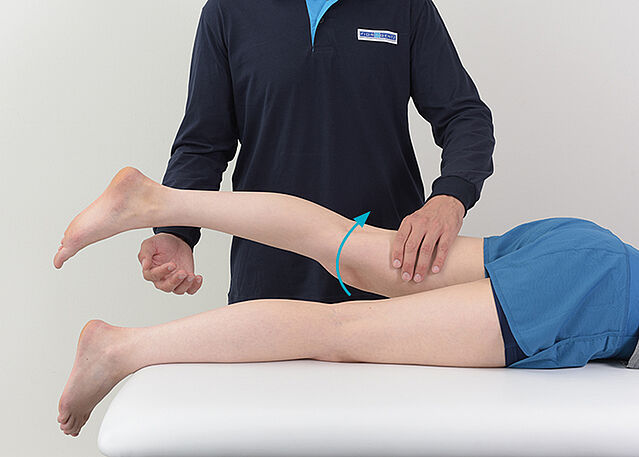
Hip Extension – Muscle Strength 5 and 4
The patient is lying on their stomach. The feet are hanging over the edge of the examination table. Press against the thigh close to the knee with one hand. Have the patient bring the hip into extension. Make sure that the pelvis stays on the examination table. At complete range of motion against gravity with full resistance, the muscle strength is 5. At range of motion against gravity with some resistance, the muscle strength is 4.Step 8/10
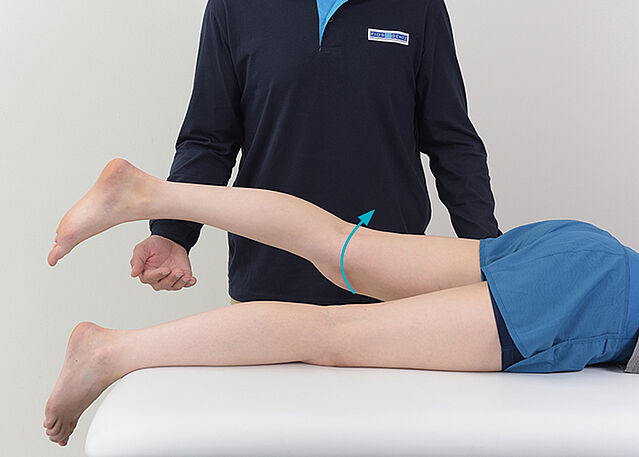
Hip Extension – Muscle Strength 3
The patient is lying on their stomach. The feet are hanging over the edge of the examination table. Have the patient bring the hip into extension. Make sure that the pelvis stays on the examination table. At range of motion against gravity, the muscle strength is 3.Step 9/10
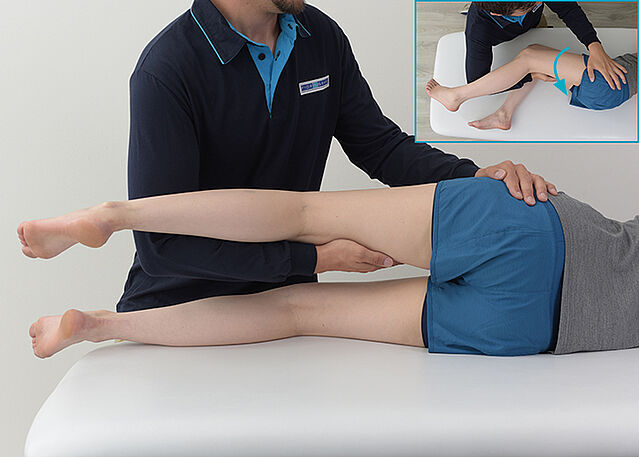
Hip Extension – Muscle Strength 2
The patient is lying on the side of the leg not to be tested. The upper leg is slightly flexed. Support and lift the upper leg with one hand. Hold the pelvis in place with the other hand without restricting the muscle function. Have the patient bring the hip into extension. At range of motion with gravity eliminated, the muscle strength is 2.Step 10/10
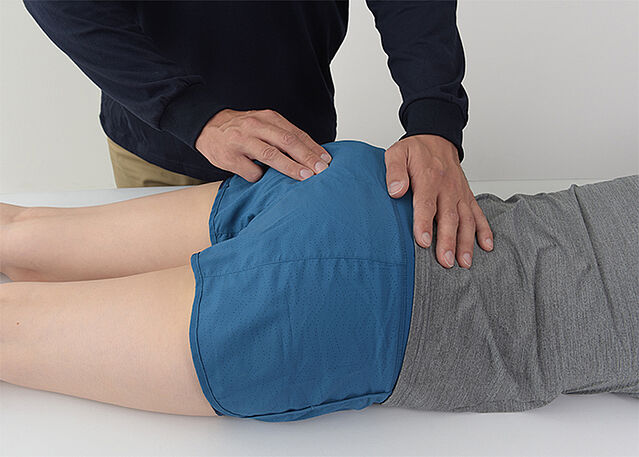
Hip Extension – Muscle Strength 1 and 0
The patient is lying on their stomach. Have the patient bring the hip into extension. Palpate if there is any muscle activity. At slight contraction with no joint motion, the muscle strength is 1. At no evidence of contraction, there is a total paralysis and the muscle strength is 0.









-
6-Minute Walk Test and Repetition of Muscle Function Test
-
Step 1/1
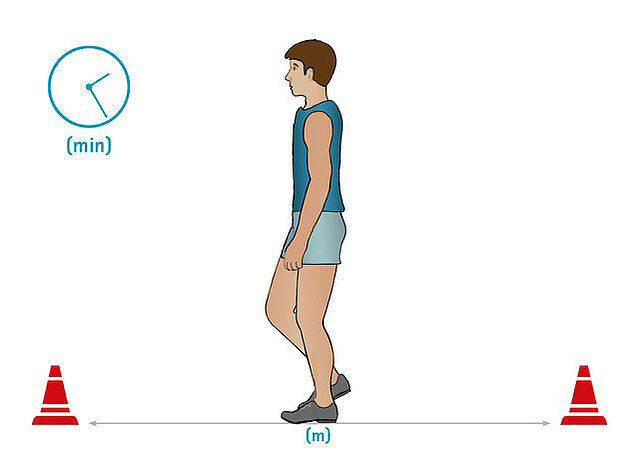
Use the 6-minute walk test to induce muscular fatigue. During this test, the patient walks up and down a previously defined route until the six minutes are over or the patient is too exhausted to continue walking. Write down the distance covered and – if the test is terminated early – the time passed.
Afterwards, immediately determine the muscle strength again (all steps from “Muscle Strength – Foot”, “Muscle Strength – Knee” and “Muscle Strength – Hip”) before continuing with the next step (Activity Level).
-
Activity Level
-
Step 1/5
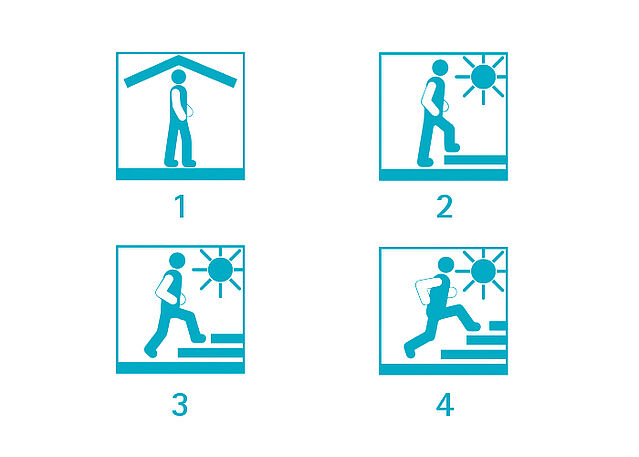
Assess the activity level together with your patient while taking into consideration foreseeable changes.
Step 2/5
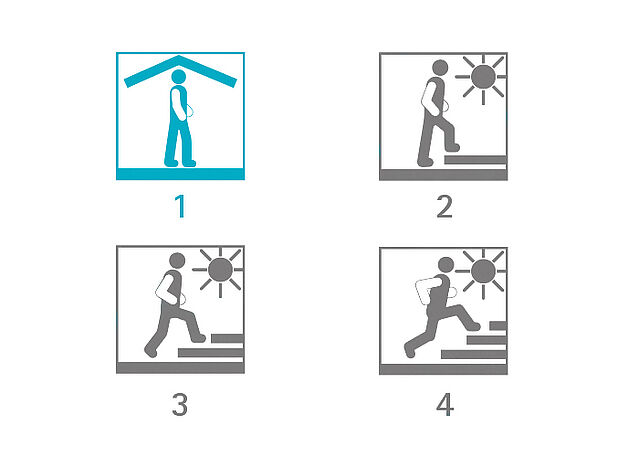
1. Indoor Walker
The patient has the ability or the potential to make transfers and to move with an orthosis on even surfaces at low walking speed (such as from the bed to the bathroom and back). Ambulation is possible for a very short distance and duration due to the physical condition of the patient.Step 3/5
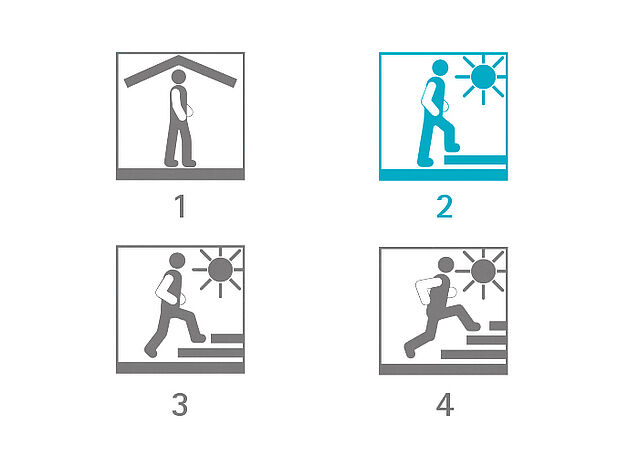
2. Restricted Outdoor Walker
The patient has the ability or the potential to move with an orthosis at low walking speed and is able to overcome small environmental obstacles such as curbs, single steps or uneven surfaces (such as taking the bus from home to their workplace and back).Step 4/5
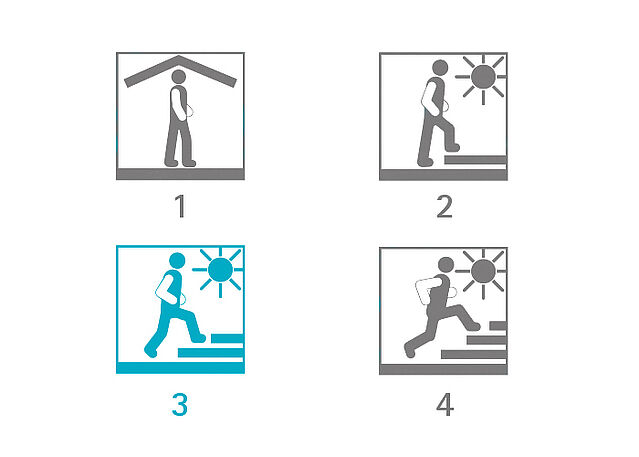
3. Unrestricted Outdoor Walker
The patient has the ability or the potential to move at medium to high and also varying speed and to overcome most environmental obstacles. Additionally, the patient can walk on open terrain and perform professional, therapeutic and other activities, which do not apply an above average mechanical load on the orthosis (such as from home to their workplace/shopping and back).Step 5/5
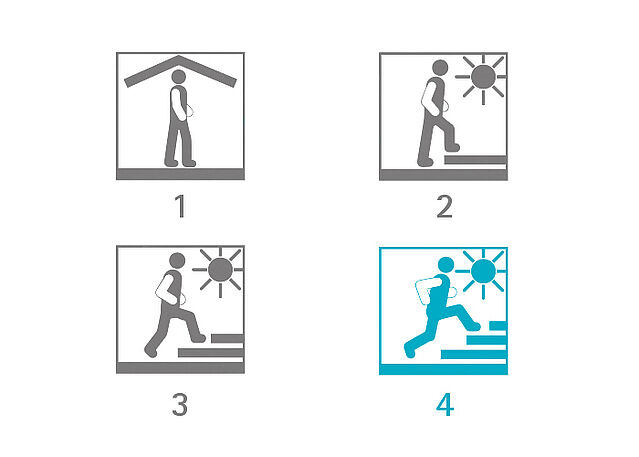
4. Unrestricted Outdoor Walker with Especially High Demands
The patient has the ability or the potential to move with an orthosis like the unrestricted outdoor walker (such as from home to their workplace/to the playground/sports/shopping and back). Additionally, the increased functional demands can generate high impact loads, tension and/or deformation on the orthosis. These patients are mainly athletes and children.




-
ap Measurement
-
Step 1/1
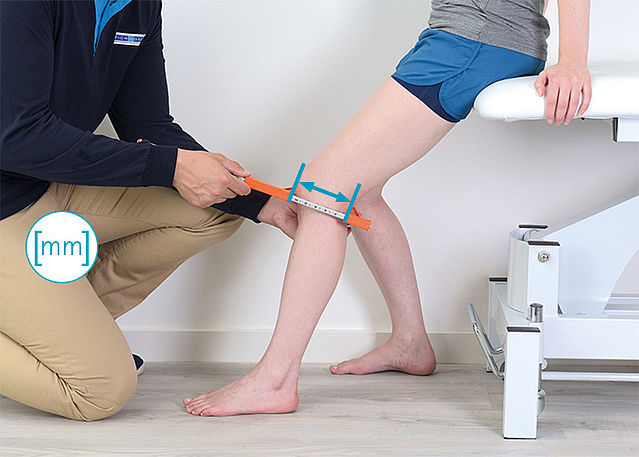
Determine the ap measurement by using a calliper.
Measure at the slightly flexed, relaxed knee. Measure at a right angle from the knee fold to the longitudinal axis of the lower leg and parallel to the movement direction.
Note: in order to avoid measuring errors, do not use the patella as a basis for determining the ap measurement, as the patella’s position can vary (e.g. in case of luxations, TEPs and patella alta).
Last Update: 6 December 2023